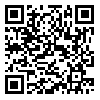Volume 7, Issue 4 (10-2025)
pbp 2025, 7(4): 11-12 |
Back to browse issues page
Download citation:
BibTeX | RIS | EndNote | Medlars | ProCite | Reference Manager | RefWorks
Send citation to:



BibTeX | RIS | EndNote | Medlars | ProCite | Reference Manager | RefWorks
Send citation to:
Nasiri A A. Anesthetic Herbs: A Review of the Most Important Anesthetic Medicinal Plants in Traditional Medicine. pbp 2025; 7 (4) :11-12
URL: http://pbp.medilam.ac.ir/article-1-302-en.html
URL: http://pbp.medilam.ac.ir/article-1-302-en.html
Anesthetic Herbs: A Review of the Most Important Anesthetic Medicinal Plants in Traditional Medicine
Department of Anesthesiology, School of Medicine, Imam Khomeini Hospital, Urmia University of Medical Sciences, Urmia, Iran , nasiriali7@gmail.com
Abstract: (291 Views)
Objective: Anesthesia has long been a critical component of medical and surgical procedures, holding a significant place not only in modern clinical practice but also in traditional systems of medicine. The use of herbal agents for inducing anesthesia has gained attention due to their sedative properties, higher safety margins, and accessibility. In this context, identifying medicinal plants with anesthetic potential in traditional Persian medicine may offer promising directions for integrative and complementary approaches.
Methods: This review was conducted to identify and document the most prominent medicinal plants traditionally used for anesthesia in Iranian traditional medicine. A comprehensive search of scientific literature was carried out using the keywords “medicinal plants,” “anesthesia,” and “traditional Iranian medicine” in reputable databases including PubMed, Scopus, Google Scholar, and Web of Science.
Results: The findings revealed a wide array of medicinal plants referenced in traditional texts for their anesthetic or sedative properties. These include Papaver rhoeas (corn poppy), Papaver somniferum (opium poppy), Melissa officinalis (lemon balm), Valeriana officinalis (valerian), Hyoscyamus niger (henbane), Datura stramonium, Syzygium aromaticum (clove), Tilia spp. (linden), Nicotiana tabacum (tobacco), Mentha piperita (peppermint), Ephedra spp., Cymbopogon citratus (lemongrass), Echinacea purpurea, Allium sativum (garlic), Borassus flabellifer (palmyra palm), Boswellia serrata (frankincense), Salix aegyptiaca (Persian willow), Passiflora incarnata (passionflower), Lavandula angustifolia (lavender), Matricaria chamomilla (chamomile), Ocimum basilicum (basil), Echium amoenum (Iranian borage), and Piper methysticum (kava).
Conclusion: This review highlights the diversity of herbal agents historically used for anesthesia within traditional Persian medicine. Further research into their mechanisms of action, bioactive compounds, and pharmacological safety could contribute to the development of safer, plant-based anesthetic alternatives.

Methods: This review was conducted to identify and document the most prominent medicinal plants traditionally used for anesthesia in Iranian traditional medicine. A comprehensive search of scientific literature was carried out using the keywords “medicinal plants,” “anesthesia,” and “traditional Iranian medicine” in reputable databases including PubMed, Scopus, Google Scholar, and Web of Science.
Results: The findings revealed a wide array of medicinal plants referenced in traditional texts for their anesthetic or sedative properties. These include Papaver rhoeas (corn poppy), Papaver somniferum (opium poppy), Melissa officinalis (lemon balm), Valeriana officinalis (valerian), Hyoscyamus niger (henbane), Datura stramonium, Syzygium aromaticum (clove), Tilia spp. (linden), Nicotiana tabacum (tobacco), Mentha piperita (peppermint), Ephedra spp., Cymbopogon citratus (lemongrass), Echinacea purpurea, Allium sativum (garlic), Borassus flabellifer (palmyra palm), Boswellia serrata (frankincense), Salix aegyptiaca (Persian willow), Passiflora incarnata (passionflower), Lavandula angustifolia (lavender), Matricaria chamomilla (chamomile), Ocimum basilicum (basil), Echium amoenum (Iranian borage), and Piper methysticum (kava).
Conclusion: This review highlights the diversity of herbal agents historically used for anesthesia within traditional Persian medicine. Further research into their mechanisms of action, bioactive compounds, and pharmacological safety could contribute to the development of safer, plant-based anesthetic alternatives.

Type of Study: Research |
Subject:
Herbal Drugs
Received: 2025/03/22 | Accepted: 2025/05/15 | Published: 2025/12/1
Received: 2025/03/22 | Accepted: 2025/05/15 | Published: 2025/12/1
References
1. Nasiri A, Abutorabi SM, Sane S. Intrathecal dexamethasone-bupivacaine combination with bupivacaine alone in spinal anesthesia for cesarean delivery. Caspian J Intern Med. 2024;15(3):414-20. doi:10.22088/cjim.15.3.414.
2. Barash PG, editor. Clinical anesthesia. Philadelphia: Lippincott Williams & Wilkins; 2009.
3. Sane S, Nasiri AA, Bahrami A, Kamalov Z, Hamoud Alshahrani S, Sajid Abdulabbas H, et al. The prophylaxis effect of ephedrine on hemodynamic variation in patients undergoing percutaneous nephrolithotomy surgery with spinal anesthesia. Int J Clin Pract. 2023;2023:8966501. doi:10.1155/2023/8966501.
4. Miller RD, Pardo M. Basics of anesthesia e-book. Philadelphia: Elsevier Health Sciences; 2011.
5. Robinson DH, Toledo AH. Historical development of modern anesthesia. J Investig Surg. 2012;25(3):141-9.
6. Alkire MT, Hudetz AG, Tononi G. Consciousness and anesthesia. Science. 2008;322(5903):876-80.
7. Rahimi M, Golparvar M, Hashemi ST, Nasiri A. The effect of adding magnesium sulfate, neostigmine and fentanyl to ropivacaine on sensory-motor block properties in lower extremity surgery under spinal anesthesia. J Isfahan Med Sch. 2022;40(689):766-74. doi:10.48305/jims.v40.i689.0766.
8. Miller RD, Eriksson LI, Fleisher LA, Wiener-Kronish JP, Cohen NH, Young WL. Miller's anesthesia e-book. Philadelphia: Elsevier Health Sciences; 2014.
9. Dixon BJ, Dixon JB, Carden JR, Burn AJ, Schachter LM, Playfair JM, et al. General anesthesia. Anesthesiology. 2005;102:1110-5.
10. Atlee JL. Complications in anesthesia e-book. Philadelphia: Elsevier Health Sciences; 2006.
11. Harris M, Chung F. Complications of general anesthesia. Clin Plast Surg. 2013;40(4):503-13.
12. Dimond EG. Acupuncture anesthesia: Western medicine and Chinese traditional medicine. JAMA. 1971;218(10):1558-63.
13. Bajwa SJ, Panda A. Alternative medicine and anesthesia: Implications and considerations in daily practice. AYU. 2012;33(4):475-80.
14. Cheng B, Hung CT, Chiu W. Herbal medicine and anaesthesia. Hong Kong Med J. 2002;8(2):123.
15. Kaye AD, Kucera I, Sabar R. Perioperative anesthesia clinical considerations of alternative medicines. Anesthesiol Clin North Am. 2004;22(1):125-39.
16. Nethathe GD, Russell SL. Traditional medicine use and the anaesthetist. South Afr J Anaesth Analg. 2014;20(6):221-5.
17. Dorman T. Herbal medicine and anesthesia. Curr Opin Anaesthesiol. 2001;14(6):667-9.
18. Ebrahimi SN, Naseri M, Hosseini SA. Iranian traditional medicine and herbal medicine: An overview of the history, principles, and concepts. J Herb Med. 2020;22:100326.
19. Zargari A. Medicinal plants. Tehran: University of Tehran Press; 1992.
20. Ghannadi A. Medicinal plants in Iran: history and perspectives. J Med Plants Res. 2015;9(24):718-26.
21. Mozaffarian V. A dictionary of Iranian plant names. Tehran: Farhang Mo’aser; 1996.
22. Shams-Ardekani MR, Rezaee MB, Yadegar A. Ethnobotanical study of medicinal plants in Iran. J Ethnopharmacol. 2013;146(2):399-410.
23. Keshavarzi Z, Shams-Ardekani MR, Mahmoudian M. Herbal medicine in the treatment of cardiovascular diseases in traditional Iranian medicine. J Tradit Complement Med. 2017;7(4):401-9.
24. Amini A, Ebrahimzadeh MA, Arzi A. Anti-inflammatory effects of medicinal plants used in Iranian traditional medicine: A review. J Complement Integr Med. 2021;18(1):123-34.
25. Malekmohammadi M, Ghanadian M, Naghizadeh M. A review on the most important medicinal plants of Iran in folk medicine. J Nat Remedies. 2018;18(1):10-20.
26. Rezaei M, Saravani R, Shams-Ardekani MR. Pharmacological properties of saffron and its constituents: A review based on traditional Iranian medicine. J Tradit Chin Med. 2019;39(5):777-85.
27. Saeidi M, Rafieian-Kopaei M, Hosseinzadeh H. Ethnopharmacology of medicinal plants in Iran: past and present. J Ethnopharmacol. 2018;210:147-57.
28. Azizi H, Mohagheghzadeh A. Medicinal plants and traditional medicine in Iran. Tehran: Institute of Medicinal Plants; 2017.
29. Abbaszadeh S, Saravani R, Shams-Ardekani MR. Herbal medicines in the treatment of diabetes mellitus in Iranian traditional medicine: A review. J Tradit Complement Med. 2016;6(4):434-43.
30. Hosseinzadeh H, Nassiri-Asl M. Pharmacological effects of Rosa damascena. Iran J Basic Med Sci. 2015;18(3):233-40.
31. Ghaderi S, Shams-Ardekani MR, Jafari SM. Traditional medicinal plants of Iran with anticonvulsant properties: A review. Iran J Pharm Res. 2019;18(1):73-84.
32. Rezazadeh S, Azadi A, Alizadeh H. Herbal plants effective in gastrointestinal diseases: Traditional Iranian medicine perspective. J Herb Med. 2020;21:100310.
33. Mirzaei H, Hosseinzadeh H. A review of traditional Persian medicine and its role in modern drug discovery. J Tradit Complement Med. 2019;9(2):91-102.
34. Ghorbani A. Review of medicinal plants used in Iranian traditional medicine for respiratory diseases. J Ethnopharmacol. 2021;270:113802.
35. Emami SA, Mohammadi H, Asgarpanah J. Chemical composition and pharmacological effects of Matricaria chamomilla: An overview. J Pharm Pharmacol. 2017;69(6):701-12.
36. Sadraei H, Asghari G, Emami SA. Medicinal plants of Iran effective on nervous system disorders. Iran J Pharm Res. 2016;15(3):459-67.
37. Zarshenas MM, Moein M, Petramfar P. A review on traditional Iranian medicinal plants effective on anxiety and depression. J Tradit Chin Med. 2018;38(4):510-21.
38. Zhang W, Zhang M, Han Y, Liu Y, Liu Y, Sun C. Combined acupuncture-medicine anesthesia used in thyroid surgery: A systematic review and meta-analysis. Medicine (Baltimore). 2023;102(1):e32582.
39. Duygun H, Epözdemir S. Phytotherapy and pain management. J Comple Alter Med Res. 2023;1(4).
40. Hansen SB. Mechanisms of general anesthesia. Annu Rev Biochem. 2025;94.
41. Chandrika UG, Karunarathna U. Anesthetics and analgesic activities of herbal medicine: review of the possible mechanism of action. Features Assess Pain Anaesth Analg. 2022;1:47-56.
42. Yousofvand N, Moloodi B. An overview of the effect of medicinal herbs on pain. Phytother Res. 2023;37(3):1057-81.
43. Haro-González JN, Castillo-Herrera GA, Martínez-Velázquez M, Espinosa-Andrews H. Clove essential oil (Syzygium aromaticum L. Myrtaceae): Extraction, chemical composition, food applications, and essential bioactivity for human health. Molecules. 2021;26(21):6387. doi:10.3390/molecules26216387.
44. Mahmud Hussen B, Noori M, Sayad B, Ebadi Fard Azar M, Sadri Nahand J, Bayat M, Babaei F, Karampour R, Bokharaei-Salim F, Mirzaei H, Moghoofei M. New potential MicroRNA biomarkers in human immunodeficiency virus elite controllers, human immunodeficiency virus infections, and coinfections with hepatitis B virus or hepatitis C virus. Intervirology. 2023 Dec 20;66(1):122–135.
45. Ghanbari A, Nouri M, Darvishi M. Evaluation of relationship between serum hemoglobin A1C level and severity of diabetic foot ulcers based on Wagner criteria. J Med Chem Sci. 2023;6:2234–2241.
46. Darvishi M, Nouri M, Zahir M, Asli M, Hejripoor SZ, Karimi E. Overview of human papillomavirus infection. Infect Disord Drug Targets. 2024 Mar 1;24(2):65–76.
47. Nouri M, Kamakifar P, Khodabandehlou N, Nahand JS, Tavakoli A, Norooznezhad F, Sorayyayi S, Babaei F, Mostafaei S, Moghoofei M. Association between Parvovirus B19 and anemia in HIV-infected patients. Med J Islam Repub Iran. 2019 Dec 16;33:137.
48. Darvishi M, Noori M, Nazer MR, Soleiman-Meigooni S, Forootan M. The relationship between Helicobacter pylori and extra-gastrointestinal infections. Iran J Med Microbiol. 2020 Nov 10;14(6):543–565.
49. Darvishi M, Hashemi Rafsanjani SMR, Nouri M, Abbaszadeh S, Heidari-Soureshjani S, Kasiri K, Rahimian G. Biological mechanisms of polyphenols against Clostridium difficile: A systematic review. Infect Disord Drug Targets. 2025 May;25(3): 18715265313944. doi: 10.2174/0118715265313944240726115600
Send email to the article author
| Rights and permissions | |
 |
This work is licensed under a Creative Commons Attribution-NonCommercial 4.0 International License. |





